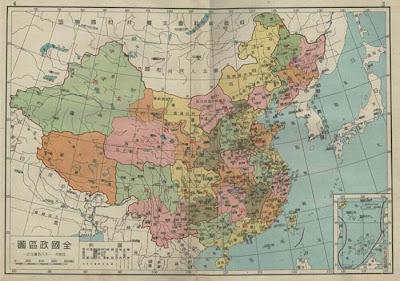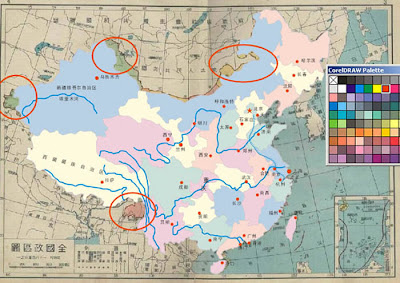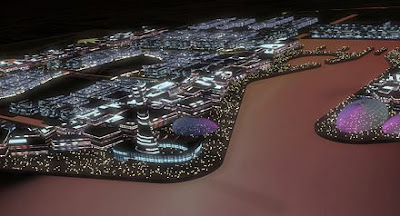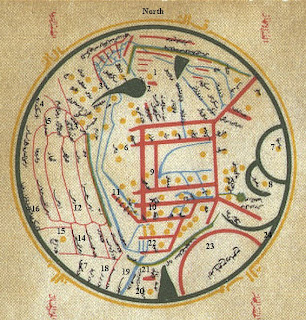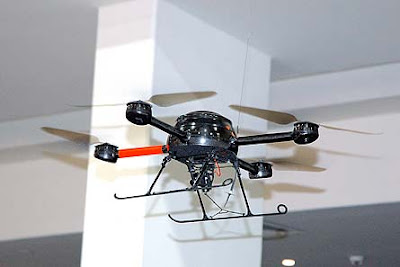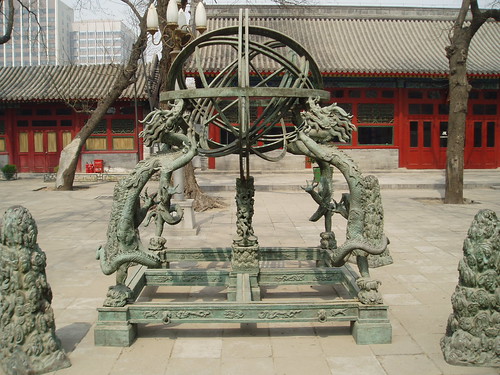 Photo courtesy of Steve Cadman of an armillary sphere at the Beijing Observatory, probably a copy of a sphere constructed by Guo Shoujing (1231-1314) in Nanjing.
Photo courtesy of Steve Cadman of an armillary sphere at the Beijing Observatory, probably a copy of a sphere constructed by Guo Shoujing (1231-1314) in Nanjing.
Following up on the previous post about calendars in China (Hot Chinese Chicks Brought to You By Pope Gregory XIII), I thought I’d take a look at the science and art behind Chinese astronomy. Calendars in China have always been of the utmost political, as well as practical, importance. As the Son of Heaven blessed with the Mandate of Heaven, the Emperor needed to be the first and last word on the heavens themselves. When the moon would be full, when an eclipse would occur, these were quite literally matters of life and death. Since China had a lunar calendar, errors were more common than on a solar calendar, and an error could lead to revolution. As Helmer Aslaksen puts it in his paper The Mathematics of the Chinese Calendar, “Every peasant would then on the first day of the month see either a waxing crescent or a waning crescent [instead of a new moon]. Why should they pay taxes and serve in the army if the emperor did not know the secrets of the heavens?” Even worse was if you were a scientist working for the Emperor, as Jesuit missionaries Adam Schall, Ferdinand Verbiest and their Chinese colleagues found out in the “Calendar Case” in the early Qing. Accused of screwing up their calculations (as well as casting a spell on the Emperors parents), they were thrown in jail. To try and defend themselves, they predicted an upcoming eclipse more accurately than the Chinese officials plotting to get them executed. But it wasn’t until an earthquake caused a fire in the Imperial Palace and a comet appeared that the Emperor thought maybe Heaven didn’t want them to die. Even then, the Jesuits Chinese colleagues were still put to death. Ed. – the laowai always get off easy, don’t they?
 So obviously alot of creativity and energy went into Chinese astronomy. There was some form of Chinese calendar as far back as the 13th or 14th century BCE, as the oracle bones show a form of dating, albeit an inaccurate one. By 589 BCE, the Chinese had it down to a cyclical correction, the Metonic cycle, one the Greeks and Babylonians would use a century later. The Chinese calendar is a lunisolar calendar, not a lunar one. The Muslim calendar is lunar, the Gregorian is solar, but the Jewish and Chinese calendars are lunisolar, meaning that they try to cram 12 months into a tropical year. Unfortunately, you come up 11 days short, so they needed to stick a leap month in every once and while, which is not easy. As Aslaksen puts it:
So obviously alot of creativity and energy went into Chinese astronomy. There was some form of Chinese calendar as far back as the 13th or 14th century BCE, as the oracle bones show a form of dating, albeit an inaccurate one. By 589 BCE, the Chinese had it down to a cyclical correction, the Metonic cycle, one the Greeks and Babylonians would use a century later. The Chinese calendar is a lunisolar calendar, not a lunar one. The Muslim calendar is lunar, the Gregorian is solar, but the Jewish and Chinese calendars are lunisolar, meaning that they try to cram 12 months into a tropical year. Unfortunately, you come up 11 days short, so they needed to stick a leap month in every once and while, which is not easy. As Aslaksen puts it:
Israel, the religious leaders would determine the date for Passover each spring by seeing if the roads were dry enough for the pilgrims and if the lambs were ready for slaughter. If not, they would add one more month. An aboriginal tribe in Taiwan would go out to sea with lanterns near the new Moon after the twelfth month. If the migratory flying fish appeared, there would be fish for New Year’s dinner. If not, they would wait one month.
The Metonic cycle was later used in both, and added some regularity. It was easier for the Jewish calendar, which, like the Gregorian calendar, is founded on a set of arithmetical rules. The Chinese and Muslim calendars, however, are astronomical. Hence Islamic calendar websites like MoonSighting.com which produces world maps and math jokes, and a Chinese New Year that keeps you guessing (is there a Chinese MoonSighting.com equivalent?)
 But before there were satellites or webpages, you had to figure out as precisely as possible what the moon was doing. This isn’t easy – due to the changing speed of the Earth in orbit, the effect of the moon on the Earth, and a whole lot of other factors that I have no clue about, there were alot of problems. One of these tools was the gnomon, which was essentially a stick in the ground, and you measured the shadows of the sun and moon. Anyway, it’s not very exciting. Another was the armillary sphere, as pictured above. You’ve seen it in Harry Potter.
But before there were satellites or webpages, you had to figure out as precisely as possible what the moon was doing. This isn’t easy – due to the changing speed of the Earth in orbit, the effect of the moon on the Earth, and a whole lot of other factors that I have no clue about, there were alot of problems. One of these tools was the gnomon, which was essentially a stick in the ground, and you measured the shadows of the sun and moon. Anyway, it’s not very exciting. Another was the armillary sphere, as pictured above. You’ve seen it in Harry Potter.
 The armillary sphere (浑仪) is ancient, and that’s why you often see it in wizards offices in movies. No one is really sure who made one first, but the Chinese astronomer Zhang Heng 张衡 was probably one of the first. Not only that, but it was water-driven, which would be used again later by Su Song. An armillary sphere basically allows you to find the position of an object in the sky in relation to the celestial equator, (equatorial AS or 赤道经纬仪) or the ecliptic (the path of the sun across the sky) (ecliptical AS or 黄道经纬仪).
The armillary sphere (浑仪) is ancient, and that’s why you often see it in wizards offices in movies. No one is really sure who made one first, but the Chinese astronomer Zhang Heng 张衡 was probably one of the first. Not only that, but it was water-driven, which would be used again later by Su Song. An armillary sphere basically allows you to find the position of an object in the sky in relation to the celestial equator, (equatorial AS or 赤道经纬仪) or the ecliptic (the path of the sun across the sky) (ecliptical AS or 黄道经纬仪).
Zhang Heng is probably better known for his earthquake detector, a giant faberge egg with dragons along the sides holding balls in their mouths. If a ball fell out, there was an earthquake in that direction.
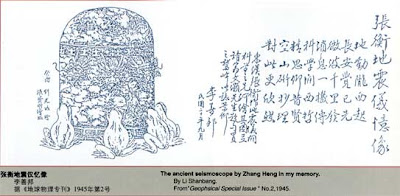
China benefited from a great deal of foreign astronomy as well. In the Tang Dynasty, the Buddhist monk Yi Xing (一行) used the Jiu Zhi Li (九执历) calendar, which was based on an Indian one, to make the Da Yan Li (大衍历). It was at this point the Chinese abandoned the metonic cycle, or an arithmetical rule, to follow the actual movement of the moon with all its eccentricities. In the Yuan Dynasty, Guo Shoujing and others were influenced by the texts of Muslim astronomers, such as Zij (1366) and al-Madkhal fi Sina’at Ahkam al-Nujum [Introduction to Astrology] (1004?). An astrolabe built to Islamic sources specification was installed in Nanjing in 1385. Guo Shoujing managed to create a new form of equatorial armillary sphere, a sort of disassembled one, the equatorial torquetum. The torquetum had a very important improvement: it wasn’t so friggin’ confusing. This is why in Chinese the equatorial sphere is typically referred to as the 浑仪 (literally “muddy apparatus”, and the torquetum is referred to as the 简仪 (“simple apparatus”). Guo Shoujing and his buddies put all this to use and created the Shoushi (授时历) calendar. Pierre Simon de LaPlace, five centuries later, would use some of Guo Shoujing’s observations, along with other ancient Chinese and Muslim sources, to demonstrate the change in obliquity in the ecliptic (the narrowing angle between the ecliptic and the celestial equator).


 In 1088, Su Song (苏颂) built a massive water-driven armillary sphere. Joseph Needham described the “Water Clock”, as it is commonly known, as follows:
In 1088, Su Song (苏颂) built a massive water-driven armillary sphere. Joseph Needham described the “Water Clock”, as it is commonly known, as follows:
“surmounted by a huge bronze power-driven armillary sphere for observation, and containing, in a chamber within, an automatically rotated celestial globe with which the observed places of the heavenly bodies could be compared. On the front of the tower was a pagoda structure with five stories, each having a door through which manikins and jacks appeared ringing bells and gongs and holding tablets to indicate the hours and other special times of the day and night. Inside the lower was the motive source, a great scoop-wheel using water and turning all the shafts working the various devices…. One must imagine this giant structure going off at full-cock every quarter of an hour with a great sound of creaking and splashing, clanging and ringing; it must have been impressive….”
 Unfortunately, the Jin invaded, took it apart and brought it back to Beijing where they couldn’t put it back together again. Later the Emperor commanded Su Song’s son, Su Xie, to rebuild it. He couldn’t. A scaled down replica is on display at Taiwan’s National Museum of Natural Science, and a 1:48 model is at the British Science Museum.
Unfortunately, the Jin invaded, took it apart and brought it back to Beijing where they couldn’t put it back together again. Later the Emperor commanded Su Song’s son, Su Xie, to rebuild it. He couldn’t. A scaled down replica is on display at Taiwan’s National Museum of Natural Science, and a 1:48 model is at the British Science Museum.
One other interesting character who contributed to the study of astronomy and calendars was Huang Daozhou (黄道周), who would later assist Prince Tang in Fuzhou against the invading Manchus of the soon-to-be Qing Dynasty. Like all of these scholars, he was a philosopher, a scientist, political figure and artist. I like this image because of hexagrams alongside the constellations:
 And then there were the Jesuits, who made some cool looking stuff. These are from the Ibiblio Vatican collection. In order, these are Matteo Ricci’s explanation of astronomy, Adam Schall van Bell’s star chart, and Ferdinand Verbiest’s strange forays into the I-Ching. Three generations of missionaries:
And then there were the Jesuits, who made some cool looking stuff. These are from the Ibiblio Vatican collection. In order, these are Matteo Ricci’s explanation of astronomy, Adam Schall van Bell’s star chart, and Ferdinand Verbiest’s strange forays into the I-Ching. Three generations of missionaries:



